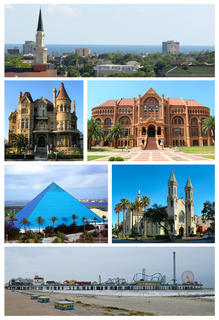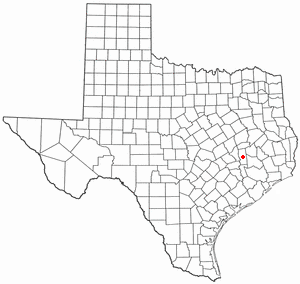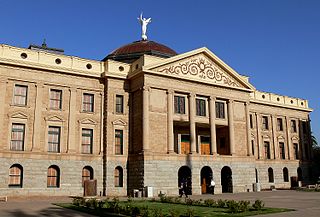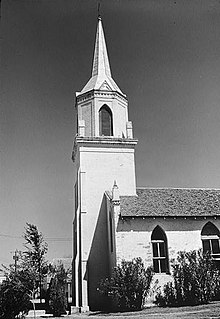
Galveston is a coastal resort city and port off the Southeast Texas coast on Galveston Island and Pelican Island in the U.S. state of Texas. The community of 209.3 square miles (542 km2), with a population of 47,743 in 2010, is the county seat of surrounding Galveston County and second-largest municipality in the county. It is also within the Houston–The Woodlands–Sugar Land metropolitan area at its southern end on the northwestern coast of the Gulf of Mexico.

Anderson is a city and county seat of Grimes County, Texas, United States. The population was 193 as of the 2020 census. The town and its surroundings are listed on the National Register of Historic Places as the Anderson Historic District.

The Financial District of Lower Manhattan, also known as FiDi, is a neighborhood located on the southern tip of Manhattan in New York City. It is bounded by the West Side Highway on the west, Chambers Street and City Hall Park on the north, Brooklyn Bridge on the northeast, the East River to the southeast, and South Ferry and the Battery on the south.

The Strand Historic District, also known as the Strand District, in downtown Galveston, Texas (USA), is a National Historic Landmark District of mainly Victorian era buildings that now house restaurants, antique stores, and curio shops. The area is a major tourist attraction for the island city and also plays host to two very popular seasonal festivals. It is widely considered the island's shopping and entertainment center. The district includes properties along the south side of Harborside Drive and both sides of The Strand and Mechanic Street from 20th Street westward to 26th Street.

James Riely Gordon was an architect who practiced in San Antonio until 1902 and then in New York City, where he gained national recognition. J. Riely Gordon is best known for his landmark county courthouses, in particular those in Texas. Working during the state's "Golden Age" (1883–1898) of courthouse construction, Gordon saw 18 of his designs erected from 1885 to 1901; today 12 remain.

The Roma Historic District in Roma, Texas preserves an intact example of a border town in the lower Rio Grande valley. The town was an important port and transshipment point on the Rio Grande from 1829 to the 1880s.

The Broadway–Armory Historic District is a historic district encompassing a mainly residential mixed-used urban area west of downtown Providence, Rhode Island.

This is a list of the National Register of Historic Places listings in Bexar County, Texas.

This is a list of the National Register of Historic Places listings in Tarrant County, Texas.

This is a list of the National Register of Historic Places listings in Lamar County, Texas.

This is a list of the National Register of Historic Places listings in Robertson County, Texas.

This is a list of the National Register of Historic Places listings in Hidalgo County, Texas

Cherry Spring School is at 5973 Ranch to Market Road 2323 in Gillespie County, in the U.S. state of Texas. It was consolidated with Fredericksburg Independent School District in 1962. The building is now used as a community center. The school was designated a Recorded Texas Historic Landmark in 1988. It was added to the National Register of Historic Places listings in Gillespie County, Texas on May 6, 2005.

This is a list of the National Register of Historic Places listings in Medina County, Texas.

This is a list of the National Register of Historic Places listings in Llano County, Texas.

This is a list of the National Register of Historic Places listings in Parker County, Texas.
Charles William Bulger was an architect in the United States, born in Delphi, Indiana. He worked with Isaac Rapp in Trinidad, Colorado, at Bulger and Rapp for several years, designing many of the city's early buildings. The firm dissolved in 1892.

The Portsmouth Downtown Historic District encompasses the historic urban core of Portsmouth, New Hampshire. With a history dating to the 17th century, Portsmouth was New Hampshire's principal seaport and the center of its economy for many decades, and the architecture of its urban center is reflective of nearly four centuries of history. The district is roughly L-shaped, radiating from the downtown Market Square area to South Street in the south and Madison and Columbia streets in the west, with more than 1,200 historically significant buildings. It was listed on the National Register of Historic Places in 2017. The district includes 35 previous listings on the National Register, and five National Historic Landmarks.
Anton F. Korn was an American architect based in Texas, known mostly for his residences. A large number of the works are in Dallas and in the Dallas enclave Highland Park, Texas. A number of his works are listed on the National Register of Historic Places for their architecture, and two or three on Galveston Island are even included in a National Historic Landmark district.




















